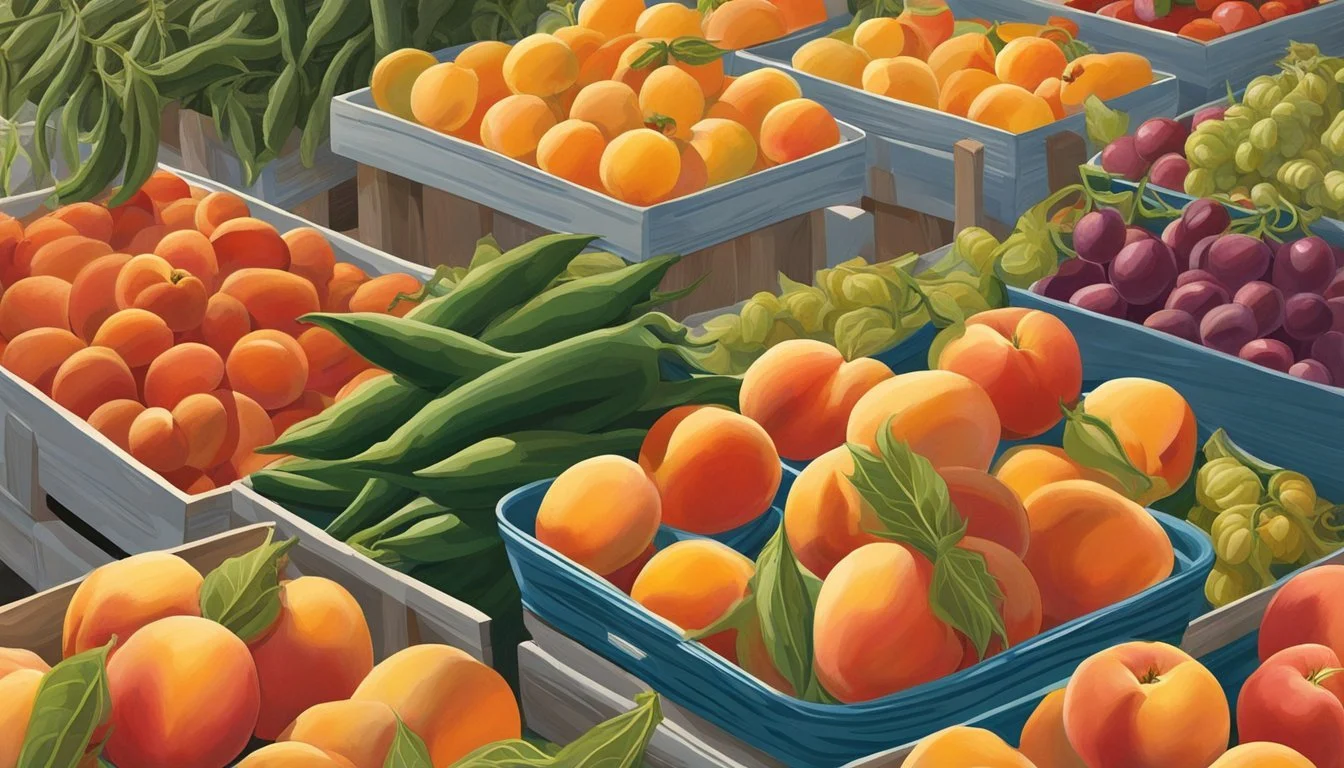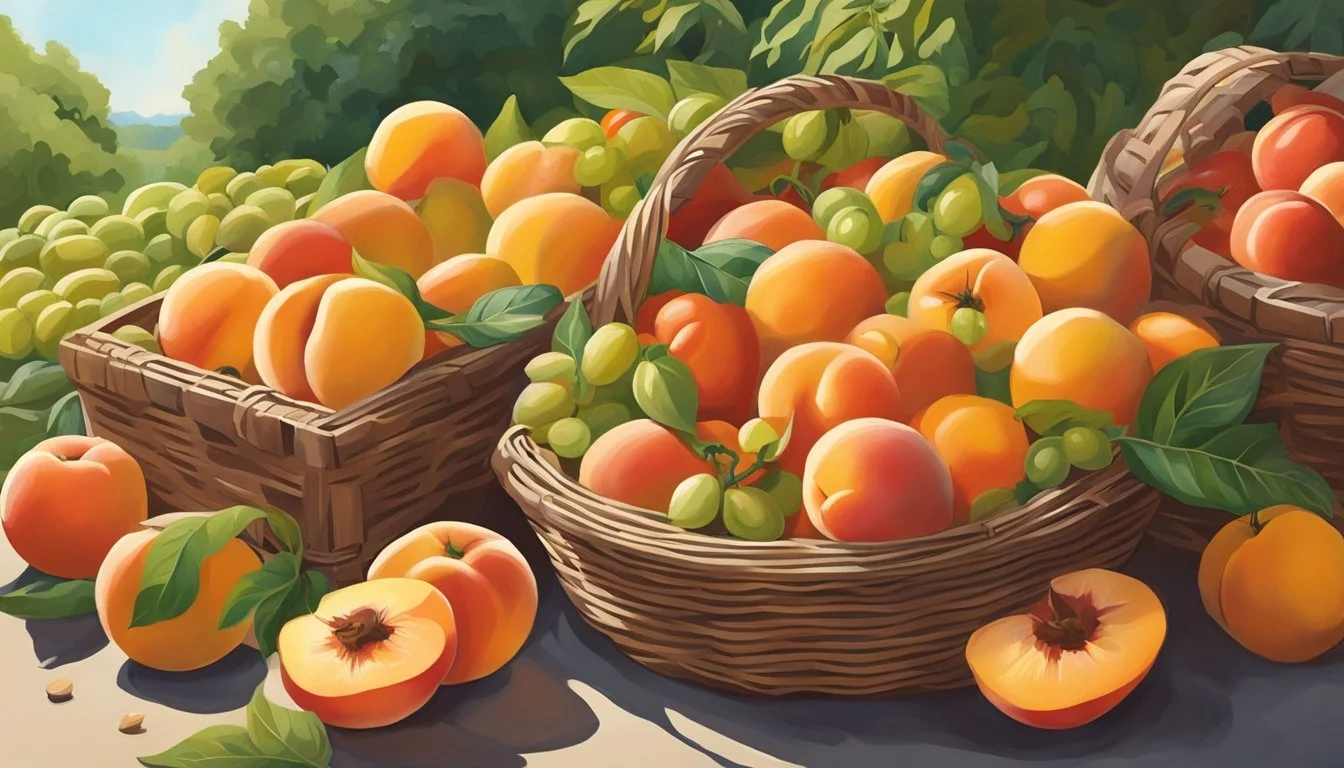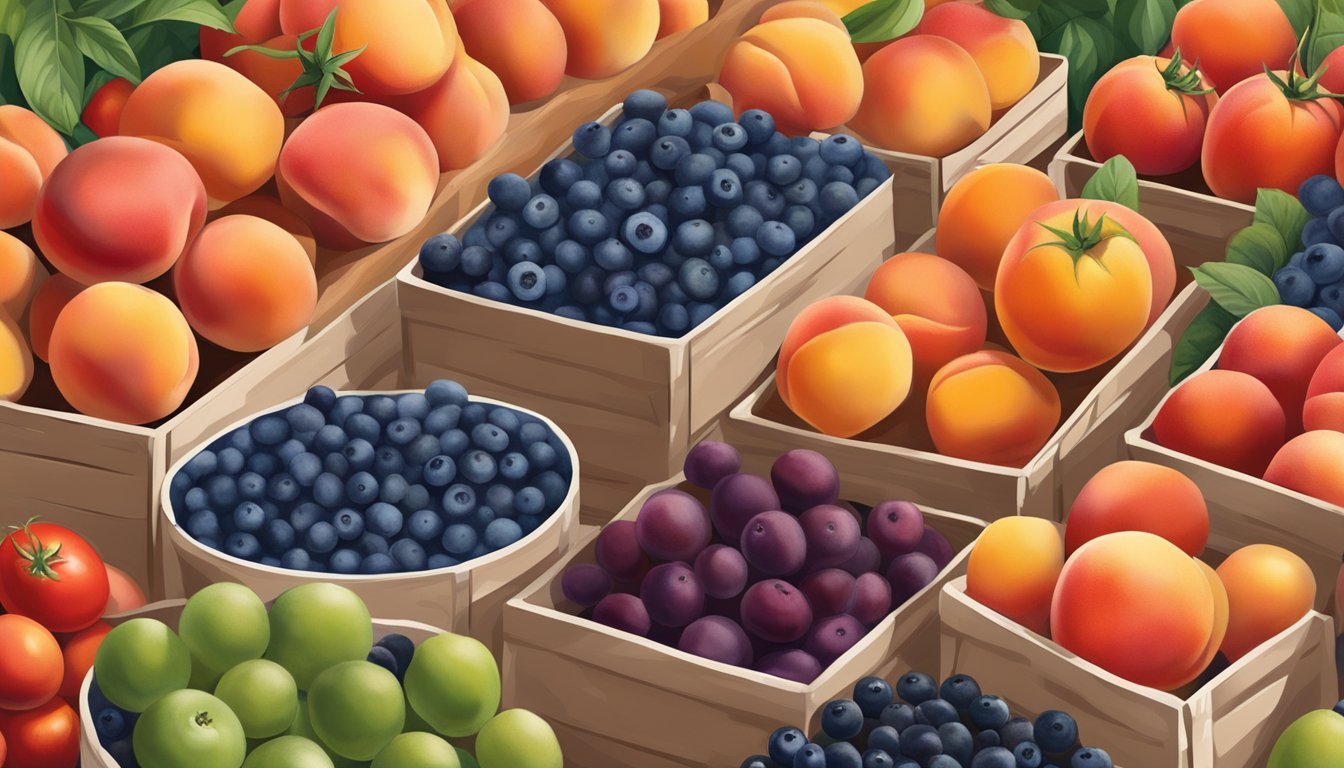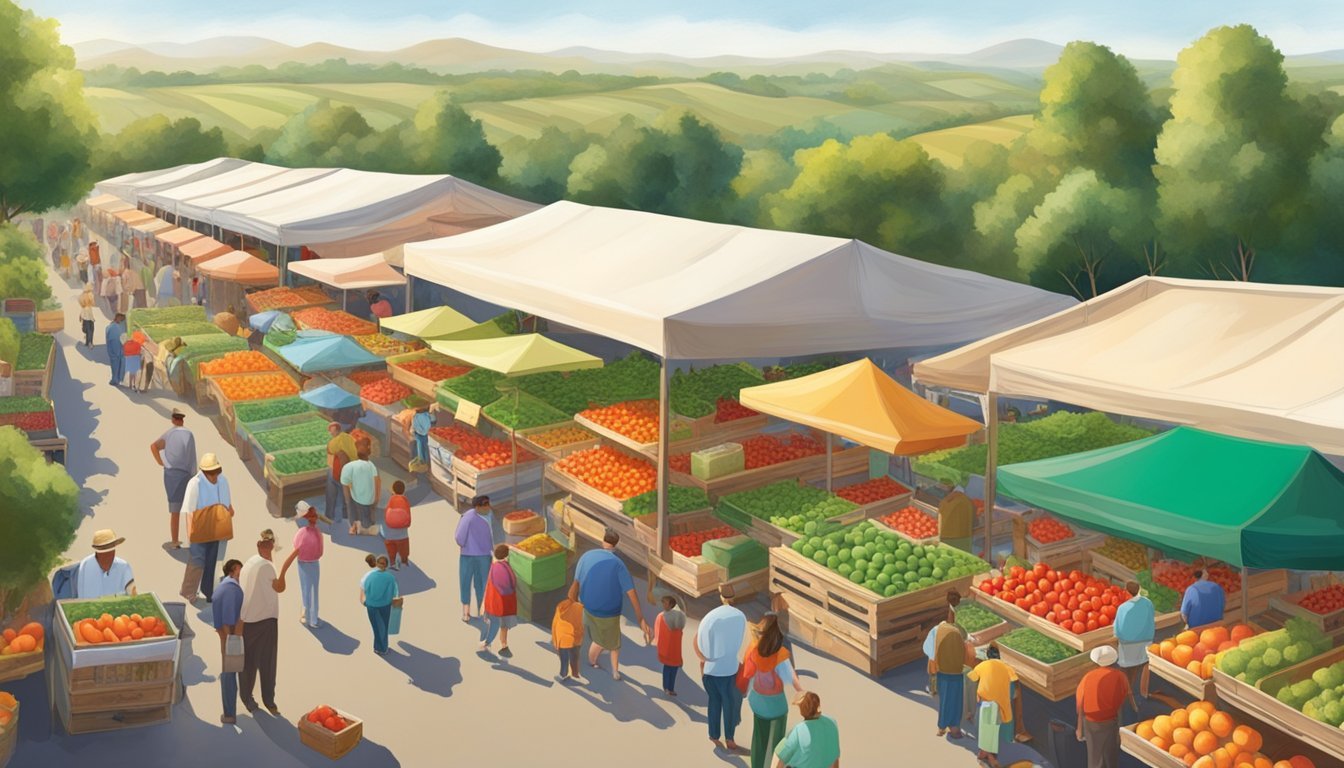South Carolina Seasonal Fruit & Vegetables in July
Your Guide to Local Produce
This Article is Part of our South Carolina Seasonal Fruit & Veg Calendar
In the warm and vibrant month of July, South Carolina's fields and orchards are bountiful with a variety of fruits and vegetables at the peak of freshness. During this midsummer period, farmers' markets and roadside stands across the state overflow with fresh produce. The climate and soil in South Carolina create an ideal environment for growing a rich assortment of seasonal items, ensuring that local consumers have access to both high-quality and flavorful food choices.
Among the fruits that ripen under the South Carolina sun in July are plump blueberries, juicy peaches, and refreshing watermelons. The state's agricultural tradition takes pride in these summer staples, with peaches being especially celebrated as South Carolina ranks second in the nation for peach production. These fruits are not only a cornerstone in the local cuisine but also contribute to the state's economy.
Vegetables such as crisp cucumbers (how long do cucumbers last?), tender green beans, and sweet corn also reach their prime in July. These vegetables, along with tomatoes that turn a rich red on the vine, form the backbone of summer cooking, offering nutrition and versatility. They are commonly found in summer dishes like salads (What wine goes well with salads?) , grilled vegetable platters, and casseroles, allowing for a celebration of South Carolina's summer flavors in every meal.
Seasonal Overview
In July, South Carolina’s agricultural bounty is in full display, with a variety of fruits and vegetables reaching their peak harvest times. The climate and season greatly influence the growing cycles and availability of produce.
Understanding Plant Hardiness and Climate
South Carolina falls largely within the USDA Hardiness Zones 7-9. Specifics of plant hardiness impact what thrives during the summer months. The state's hot and humid climate in July enables the successful growth of many heat-loving plants. Summer is a critical time for fruiting as higher temperatures accelerate growth and ripening.
The Role of the Season in Harvest Times
The season plays a pivotal role in determining harvest schedules. Summer crops are adapted to long, warm days. In July, the following table outlines some of South Carolina's seasonal produce and their typical harvest times:
Fruit or Vegetable Harvest Period Peaches May - August Tomatoes June - October Blueberries June - August Watermelons July - September Sweet Corn July - September
These harvest periods can vary slightly based on specific regional climate conditions and microclimates within the state. The growers carefully monitor their crops to determine the optimal harvest time, ensuring that consumers receive the freshest produce with maximum flavor and nutritional value.
Fresh Picks for July
July in South Carolina brims with a bounty of fruits and vegetables reaching their peak. Farmers' markets and local gardens overflow with the season's freshest produce for a taste of summer's abundance.
Predominant Fruits
Peaches: South Carolina peaches are juicy and abundant in July. These stone fruits grow plump and are ideal for everything from pies to preserves.
Watermelon: A summertime favorite, watermelons are at their sweetest now. Look for ones with a deep yellow spot, indicating ripeness.
Blueberries: Antioxidant-rich blueberries are plentiful. They are perfect for fresh eating, baking, or jam-making.
Melons: Varieties such as cantaloupe (how long does cantaloupe last?)and honeydew are ripe for the picking, best chosen by fragrance and a slightly soft stem end.
Abundant Vegetables
Tomatoes: Vine-ripened tomatoes are especially flavorful this month. They make a great addition to salads, sandwiches, and sauces.
Corn: Ears of corn are sweet and tender, ideally eaten soon after harvest for the best taste.
Squash: Summer squash varieties are readily available and versatile for cooking.
Okra: Fresh okra, a southern staple, is crisp and perfect for frying or adding to gumbo.
Cucumbers: Crisp cucumbers are cooling on hot July days, excellent for salads or pickling.
Peppers: A range of peppers from sweet to hot varieties is ready for harvest, adding a kick to summer dishes.
Selecting and Storing July Produce
In South Carolina, July is a vibrant month for harvesting and purchasing fresh, seasonal produce. Farmers' markets are abundant with fruits and vegetables, each with specific selection and storage guidelines to maintain their freshness and flavor.
Ripe for the Picking: Tips on Selection
When selecting peaches, they should have a fragrant aroma and give slightly to gentle pressure. Tomatoes are best chosen when they are brightly colored and firm, with a little give. Watermelons should be heavy for their size with a creamy yellow spot where they rested on the ground. For cucumbers, look for firm, dark green cucumbers without any wrinkles or soft spots.
Peaches: Fragrant, yield to gentle pressure.
Tomatoes: Bright color, firm with slight give.
Watermelons: Heavy for size, creamy yellow ground spot.
Cucumbers: Firm, dark green, no wrinkles.
Storage Recommendations for Freshness
After harvesting or purchasing, storing fresh produce correctly is key to extending its shelf life. Peaches can ripen at room temperature and then be moved to the fridge to slow down the ripening process. Tomatoes should be stored at room temperature away from direct sunlight to preserve their flavor and texture. Store watermelons in a cool place, and once cut, wrap the cut surface and refrigerate. Cucumbers should be stored in the fridge, preferably in the crisper drawer.
Peaches: Ripen at room temp, then refrigerate.
Tomatoes: Room temperature, away from sunlight.
Watermelons: Cool place; refrigerate once cut.
Cucumbers: Refrigerate, use crisper drawer.
Health and Nutrition
Choosing seasonal produce in South Carolina during July contributes to better nutritional outcomes and a more balanced diet. Fruits and vegetables in season tend to be fresher and are often more nutrient-dense than out-of-season counterparts.
Nutritional Benefits of Seasonal Produce
Seasonal fruits and vegetables harvested in their peak month typically offer higher concentrations of vitamins, minerals, and antioxidants. For example:
Kale and other leafy greens, abundant in July, are rich in vitamin C, vitamin K, and iron.
Cantaloupe is a sweet addition to the summer fruit assortment, providing a significant amount of vitamin A, vitamin C, and potassium.
Eggplant (What wine goes well with eggplant?), often harvested in the summer, contains fiber, antioxidants, and a variety of vitamins.
The following table outlines key nutrients found in these July-harvested foods:
Food Item Significant Nutrients Kale Vitamin C, Vitamin K, Iron Greens Folate, Calcium, Fiber Cantaloupe Vitamin A, Vitamin C, Potassium Eggplant (What wine goes well with eggplant?) Fiber, Antioxidants, Vitamins B1, B6
Incorporating Seasonal Produce into a Balanced Diet
Incorporating July's seasonal produce into one's diet can enhance meal balance and contribute to overall health:
Add chopped kale to salads, or blend into smoothies for a nutrient boost.
Mix diced cantaloupe into breakfast yogurts or fruit salads for a hydrating start to the day.
Grill or roast slices of eggplant as a side dish or incorporate it into pastas and stews.
One should aim to create colorful plates with a variety of these seasonal offerings to ensure a range of nutrients are consumed.
Cultivating Your Own
July in South Carolina presents an excellent opportunity for individuals to cultivate their own produce. With the state's warm climate, a variety of fruits and vegetables thrive when tended to properly. This section offers guidance on backyard gardening and explores the benefits of community gardens and urban farming, focusing on agriculture, gardening, and the availability of crops during this peak growing season.
Backyard Gardening Tips
Gardening in one's own backyard allows for a personal and hands-on approach to growing seasonal produce. In July, the emphasis is on maintaining and harvesting summer crops while preparing for late summer and early fall planting. Here are some specific tips for South Carolina gardens:
Watering: Ensure consistent watering, especially in the hot July weather, to keep plants hydrated and healthy.
Pest Control: Regularly inspect plants and employ natural deterrents to manage pests common in the South Carolina summer.
Mulching: Apply mulch to retain soil moisture, regulate temperature, and suppress weeds.
Harvest: Pick ripe produce promptly to encourage further production and maintain plant health.
Here's a selection of produce ideal for backyard gardens in July, assuming proper care and conditions:
Vegetables Fruits Tomatoes Watermelons Peppers Peaches Cucumbers Berries Squash Cantaloupes Okra Beans
Community Gardens and Urban Farming
Community gardens and urban farming initiatives are valuable assets, enabling those without sufficient gardening space to participate in cultivating fresh produce. These collaborative efforts often offer:
Education: They provide a space for learning about sustainable agriculture and gardening techniques.
Resource Sharing: Participants can share tools, knowledge, and sometimes even manpower.
Social Interaction: An excellent way for individuals to connect with others who have an interest in growing food and supporting local agriculture.
In South Carolina, community gardens and urban farms often feature crop availability that aligns with local growing seasons, ensuring that participants can enjoy fresh, seasonal produce. This local engagement with agriculture not only sustains healthy eating habits but also bolsters the community's connection to its food sources.
Impact on Local Economy
Buying seasonal fruits and vegetables directly benefits South Carolina's economy. It is a substantial support system for local agriculture and farmers markets, enhancing food accessibility and bolstering economic stability within the state.
The Importance of Supporting Local Agriculture
Local agriculture forms the backbone of South Carolina's rural economy. Investment in local farms is a direct injection of financial resources into the community, creating jobs and sustaining families who have cultivated the land for generations. When consumers purchase from local farms, they ensure that a larger share of the revenue remains within the state's economy, promoting a cycle of prosperity that benefits both the consumer and the producer.
Farmers Markets and Food Accessibility
Farmers markets strategically positioned throughout South Carolina serve as critical points for distributing freshly harvested produce. They bridge the gap between rural and urban areas, allowing city dwellers to have access to nutritious, farm-fresh goods. This network increases the availability of seasonal fruits and vegetables, which, in turn, stimulates the local economy by maintaining a consistent demand for locally-grown produce. By providing a reliable outlet for their goods, farmers markets help sustain local farms and contribute to a robust agricultural sector.
Each interaction at a farmers market or with local produce is a thread that weaves together the fabric of South Carolina's economy, creating a resilient and diversified agricultural landscape.
July Recipes and Preparation
In South Carolina, July brings an abundance of fresh produce to the table. From vibrant beans to juicy tomatoes, this summer month offers a variety of ingredients perfect for creating refreshing and nourishing meals.
Seasonal Recipes
Beans:
Sautéed Green Beans: Quick and easy, they can be made more flavorful with garlic, sliced almonds, and a squeeze of lemon juice.
Three-Bean Salad: A chilled dish combining green beans, kidney beans (how long do kidney beans last?), and garbanzo beans, tossed with diced onions and a tangy vinaigrette.
Broccoli (how long does broccoli last?):
Broccoli Salad: Chilled broccoli florets mixed with crispy bacon bits, shredded cheese, and a creamy dressing.
Roasted Broccoli: Tossed with olive oil, garlic, and a pinch of salt, then oven-roasted until crispy on the edges.
Cabbage:
Coleslaw: Shredded cabbage, carrots, and a tangy mayonnaise-based dressing, perfect as a side for barbecues.
Stuffed Cabbage Rolls: Cabbage leaves filled with a savory mixture of rice, ground meat, and herbs, simmered in tomato sauce.
Lettuce:
Summer Salad: A fresh lettuce blend with seasonal berries, feta cheese, and a light vinaigrette.
Lettuce Wraps: A healthier option with ground turkey or tofu (how long does tofu last?), sautéed with vegetables and wrapped in crisp lettuce leaves.
Tomato:
Caprese Salad (What wine goes well with caprese salad?): Slices of ripe tomatoes layered with fresh mozzarella, basil leaves, olive oil, and balsamic glaze.
Classic Tomato Sandwich: Thick tomato slices on hearty bread with mayonnaise, salt, and pepper – a July staple in the South.
Cooking and Preparation Tips
Beans: Keep them crisp by cooking quickly on high heat or blanching in boiling water followed by an ice bath.
Broccoli: To retain maximum nutrients, steam broccoli until it's bright green and tender-crisp rather than boiling it.
Cabbage: For slaws and salads, slicing cabbage thinly makes for a more pleasing texture and better incorporation of dressings.
Lettuce: Wash and pat dry lettuce leaves before use to ensure they are clean and crisp. A salad spinner can be quite handy for this.
Tomato: To concentrate their flavor, slow-roast tomatoes at a low temperature in the oven with olive oil and herbs.








